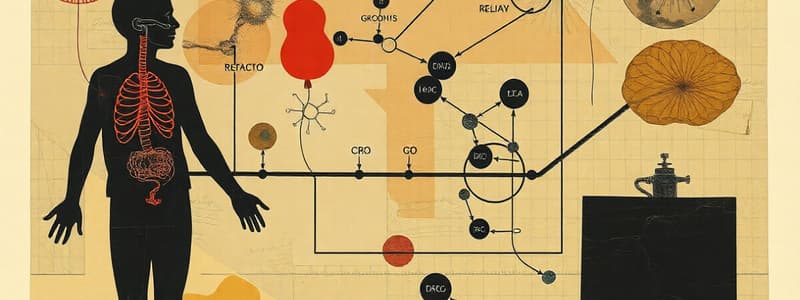Podcast
Questions and Answers
What is the primary role of the mitochondria in aerobic respiration?
What is the primary role of the mitochondria in aerobic respiration?
- Photosynthesis of glucose
- Production of carbon dioxide
- Oxidation of pyruvate (correct)
- Synthesis of fatty acids
Which compound links glycolysis to the citric acid cycle?
Which compound links glycolysis to the citric acid cycle?
- Oxaloacetate
- NADH
- Lactate
- Acetyl CoA (correct)
What critical role does Coenzyme A play in cellular metabolism?
What critical role does Coenzyme A play in cellular metabolism?
- Amino acid synthesis
- Energy storage
- Electron transport
- Acyl carrier (correct)
What is the function of the mitochondrial pyruvate carrier (MPC)?
What is the function of the mitochondrial pyruvate carrier (MPC)?
Which process occurs before the citric acid cycle can begin?
Which process occurs before the citric acid cycle can begin?
Which of the following coenzymes is derived from vitamin B1?
Which of the following coenzymes is derived from vitamin B1?
What is generated per turn of the citric acid cycle?
What is generated per turn of the citric acid cycle?
How does the citric acid cycle start its process?
How does the citric acid cycle start its process?
What is the key purpose of the NADH and FADH2 produced in the citric acid cycle?
What is the key purpose of the NADH and FADH2 produced in the citric acid cycle?
Which components regulate the TCA cycle in response to energy demand?
Which components regulate the TCA cycle in response to energy demand?
Flashcards
Citric Acid Cycle
Citric Acid Cycle
A central metabolic pathway that completes the oxidation of pyruvate to CO2, generating energy in the form of ATP, NADH, and FADH2.
Krebs Cycle
Krebs Cycle
A series of eight enzyme-catalyzed reactions in the mitochondria where acetyl CoA is oxidized to CO2, producing energy carriers and generating intermediates for other metabolic pathways.
Oxidative Phosphorylation
Oxidative Phosphorylation
The process of producing ATP from NADH and FADH2 generated during the Krebs cycle using a series of protein complexes in the inner mitochondrial membrane.
Acetyl CoA
Acetyl CoA
Signup and view all the flashcards
Pyruvate Dehydrogenase Complex (PDH Complex)
Pyruvate Dehydrogenase Complex (PDH Complex)
Signup and view all the flashcards
Aerobic respiration
Aerobic respiration
Signup and view all the flashcards
Pyruvate
Pyruvate
Signup and view all the flashcards
Pyruvate dehydrogenase (PDH) complex
Pyruvate dehydrogenase (PDH) complex
Signup and view all the flashcards
Coenzyme A
Coenzyme A
Signup and view all the flashcards
Mitochondrial pyruvate carrier (MPC)
Mitochondrial pyruvate carrier (MPC)
Signup and view all the flashcards
Study Notes
Cellular Respiration Overview
- Cellular respiration is the process by which cells convert glucose into ATP (adenosine triphosphate), the primary energy currency of the cell.
- The process involves several stages, including glycolysis, the transition reaction, the Krebs cycle, and oxidative phosphorylation.
Glycolysis
- Glycolysis occurs in the cytoplasm and is the breakdown of glucose (a 6-carbon molecule) into two molecules of pyruvate (a 3-carbon molecule).
- Two ATP molecules are used as initial investment, but four ATP molecules are produced, resulting in a net gain of 2 ATP molecules.
- Two molecules of NAD+ are also reduced to NADH; carrying electrons to the electron transport chain.
Transition Reaction
- The transition reaction links glycolysis to the Krebs cycle.
- Pyruvate is transported into the mitochondrial matrix and converted to acetyl CoA (a 2-carbon molecule).
- A carbon dioxide molecule is released, and one NAD+ is reduced to NADH.
Krebs Cycle (Citric Acid Cycle)
- The Krebs cycle takes place in the mitochondrial matrix.
- Acetyl CoA combines with oxaloacetate to form citrate, starting the cycle.
- The cycle releases two molecules of carbon dioxide.
- One ATP, three NADH, and one FADH2 are produced per cycle, per acetyl CoA entering.
- The cycle regenerates oxaloacetate, allowing the cycle to continue.
Oxidative Phosphorylation
- Oxidative phosphorylation occurs across the inner mitochondrial membrane.
- NADH and FADH2 deliver electrons to the electron transport chain.
- Electrons are passed through a series of protein complexes, releasing energy that is used to pump protons (H+) across the membrane, creating a proton gradient.
- The flow of H+ back into the matrix through ATP synthase drives the synthesis of ATP, a process called chemiosmosis.
- Oxygen is the final acceptor of electrons in the electron transport chain, forming water.
Summary of ATP Production
- Glycolysis produces 2 ATP.
- Transition reaction produces no ATP directly.
- Krebs cycle produces 2 ATP.
- Oxidative phosphorylation produces 32-34 ATP (depending on cell).
Other cellular processes
- Pyruvate enters the mitochondria only when O2 is present.
- The citric acid cycle has eight steps, each catalyzed by a specific enzyme.
- The acetyl group of acetyl CoA joins the cycle by combining with oxaloacetate, forming citrate.
- The reactions of the citric acid cycle follow a chemical logic.
- The TCA cycle extracts the max potential energy from the pyruvate.
- The cycle oxidizes organic fuel derived from pyruvate.
Studying That Suits You
Use AI to generate personalized quizzes and flashcards to suit your learning preferences.




